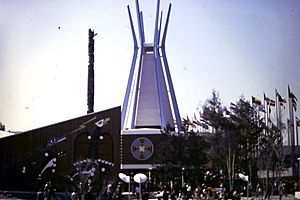Indians of Canada Pavilion facts for kids
The Indians of Canada Pavilion was a special building at the 1967 World's Fair in Montreal, Quebec, Canada. This pavilion was built to show the world the rich culture and history of Indigenous Peoples in Canada. It also shared important messages about the challenges they faced.
Organizers worked closely with Indigenous leaders and advisors to create the exhibits. The messages inside were strong and honest, sometimes surprising the Canadian government and the public. The pavilion showed history from an Indigenous point of view. It highlighted how non-Indigenous Canadians and the government had impacted Indigenous cultures. This included the suppression of their traditions, the forced attendance of children at residential schools, and the effects of colonialism on their lives.
Contents
What Was the Pavilion About?
The main goal of the pavilion was to answer a big question: "What do you want to tell the people of Canada and the World when they come to Expo in 1967?" The Indigenous people's answer was clear. They wanted to show their struggle to live in a modern world while keeping their unique identity and their ancestors' values.
Messages and Artworks
Visitors walked through different sections, each with powerful messages. For example, signs read: "When the White Man Came We Welcomed Him With Love." Another said: "The great explorers of Canada traveled in Indian canoes, wore Indian snow-shoes, ate Indian food, lived in Indian houses. They could not have lived or moved without Indian friends." These messages were right at the start of the pavilion.
The exhibits featured many examples of Indigenous art and artifacts. There was a very large Totem Pole outside. Inside, you could see birch bark canoes, rawhide snowshoes, sculptures, and murals. Famous Indigenous artists like Alex Janvier, Noel Wuttunee, and Norval Morriseau contributed their work. Traditional clothing and beadwork were also on display. Important historical documents, like the Royal Proclamation of 1763 and several Crown Treaties, were also shown.
Towards the end of the pathway, there was a section showing Indigenous people in modern jobs. These photos showed them as tradespeople, craftspeople, and farmers. This part was more hopeful and was designed by a government branch that worked with Indigenous affairs.
The final area was a large space with a central imitation fire pit. Visitors were invited to sit there and think about the future of Indigenous people in Canada.
Indigenous Hostesses
Thirteen Indigenous women were chosen from many applicants to work as hostesses. Their job was to guide visitors and explain the exhibits. They helped people understand Indigenous culture better. These women came from various First Nations, including the Siksika, Haisla, Haida, Mi’kmaq, Ojibwa, Mohawk, Innu, and Nlaka'pamux.
Key Organizers
One of the main people who helped organize the Indian Pavilion was Noel Wuttunee. He was a Cree artist. He worked with a lawyer named William Wuttunee, who was the president of the National Indian Council. Together, they made sure that the pavilion told a different, important story about Canada's history.
See also


